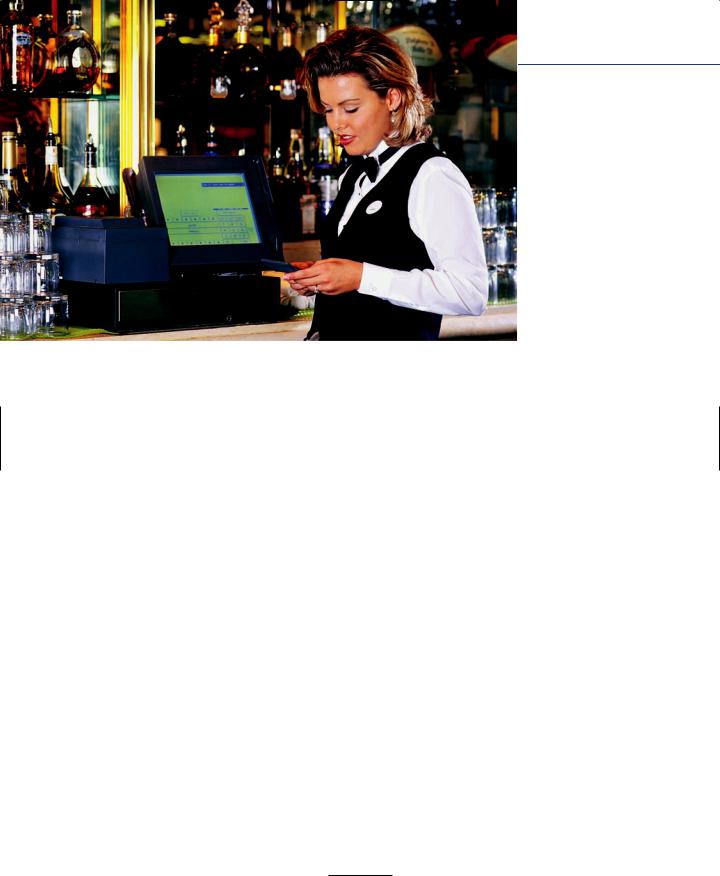
- •CONTENTS
- •PREFACE
- •Content—Benefits for Students
- •Content—Benefits for Instructors
- •Features of the Book for Students and Instructors
- •Supplementary Materials
- •Acknowledgments
- •What Is Hospitality Management?
- •The Manager’s Role in the Hospitality Industry
- •Why Study in a Hospitality Management Program?
- •Planning a Career
- •Employment as an Important Part of Your Education
- •Getting a Job
- •Employment at Graduation
- •The Outlook for Hospitality
- •Summary
- •Managing Change
- •Demand
- •Supply
- •Workforce Diversity
- •The Impact of Labor Scarcity
- •Summary
- •The Varied Field of Food Service
- •The Restaurant Business
- •The Dining Market and the Eating Market
- •Contemporary Popular-Priced Restaurants
- •Restaurants as Part of a Larger Business
- •Summary
- •Restaurant Operations
- •Making a Profit in Food Service Operations
- •Life in the Restaurant Business
- •Summary
- •Chain Restaurant Systems
- •Independent Restaurants
- •Franchised Restaurants
- •Summary
- •Competitive Conditions in Food Service
- •The Marketing Mix
- •Competition with Other Industries
- •Summary
- •Self-Operated Facilities
- •Managed-Services Companies
- •Business and Industry Food Service
- •College and University Food Service
- •Health Care Food Service
- •School and Community Food Service
- •Other Segments
- •Vending
- •Summary
- •Consumer Concerns
- •Food Service and the Environment
- •Technology
- •Summary
- •The Evolution of Lodging
- •Classifications of Hotel Properties
- •Types of Travelers
- •Anticipating Guest Needs in Providing Hospitality Service
- •Service, Service, Service
- •Summary
- •Major Functional Departments
- •The Rooms Side of the House
- •Hotel Food and Beverage Operations
- •Staff and Support Departments
- •Income and Expense Patterns and Control
- •Entry Ports and Careers
- •Summary
- •The Economics of the Hotel Business
- •Dimensions of the Hotel Investment Decision
- •Summary
- •The Conditions of Competition
- •The Marketing Mix in Lodging
- •Product in a Segmented Market
- •Price and Pricing Tactics
- •Place—and Places
- •Promotion: Marketing Communication
- •Summary
- •The Importance of Tourism
- •Travel Trends
- •The Economic Significance of Tourism
- •The United States as an International Tourist Attraction
- •Businesses Serving the Traveler
- •Noneconomic Effects of Tourism
- •Summary
- •Motives and Destinations
- •Mass-Market Tourism
- •Planned Play Environments
- •Casinos and Gaming
- •Urban Entertainment Centers
- •Temporary Attractions: Fairs and Festivals
- •Natural Environments
- •On a Lighter Note. . .
- •Summary
- •Management and Supervision
- •The Economizing Society
- •The Managerial Revolution
- •Management: A Dynamic Force in a Changing Industry
- •What Is Management?
- •Summary
- •Why Study Planning?
- •Planning in Organizations
- •Goal Setting
- •Planning in Operations
- •The Individual Worker as Planner
- •Long-Range Planning Tools
- •Summary
- •Authority: The Cement of Organizations
- •Departmentalization
- •Line and Staff
- •Issues in Organizing
- •Summary
- •Issues in Human-Resources Management
- •Fitting People to Jobs
- •Recruiting
- •Selection and Employment
- •Training
- •Retaining Employees
- •Staff Planning
- •Summary
- •The Importance of Control
- •Control and the “Cybernetic Loop”
- •Tools for Control
- •Summary
- •Leadership as Viewed by Social Scientists
- •Why People Follow
- •Leadership Theories
- •Communication
- •The Elements of Leading and Directing
- •Developing Your Own Leadership Style
- •Summary
- •A Study of Service
- •Rendering Personal Service
- •Managing the Service Transaction
- •How Companies Organize for Service
- •Summary
- •INDEX

Technology 253
Technology
Back in the 1970s, a researcher looked into the future of food service, and this is what he saw:
The restaurant of the future will be automated. One individual will be capable of running a 10,000-meal-a-day commissary. Computer-controlled, automated equipment will run the food processing operation from storeroom to cleanup as well as take care of inventory control and the reordering process. In addition, the computer will handle all records, write all necessary business reports (including the annual report), forecast requirements, and perform all cost accounting duties.
Customers will dine in a computer-manipulated environment of aromatic and visual stimuli. They will stand before lighted menus picturing various entrées and punch out selections at order stations. Within 21⁄2 minutes, they will be served the meal via conveyor belt running with the wall and stopping at the proper table. Dish busing commences upon the customer arising from the seat. Dirty dishes move onto a conveyor belt within an adjacent wall. The dishwashing process is completely automated. A 200-seat restaurant will require four employees and a manager.18
If technology can put an astronaut on the moon, it can surely bus tables. However, it’s not what is technically possible that counts; it’s what makes economic sense. In the foreseeable future, even in the face of steeply rising wages, the 10,000-meal-a-day commissaries that come into use will require a good many more employees, because it will make economic sense. Although a computer-operated food production, storage, and cleanup system is theoretically possible, it would be like using a computer just to add up a grocery bill. Less-expensive methods are available.
On the other hand, touch-screen ordering stations have become a common tool in restaurants, although they are more commonly used for servers to place orders than by guests. Even where they are available for use by guests, an alternative interpersonal ordering system is also available.
We have heard reports of “six-armed robots” being designed for use in food service for years, and it could be that they are finally coming to fruition. One of the most popular booths at the NRA show in 2000 belonged to “Flipper.” A robot that previously had been employed by IBM for the purpose of assembling computers, it has now been redesigned to work in restaurant kitchens and is being marketed by AccuTemp Products, Inc. The estimated cost is $150,000 for a five-year lease.19
Although the computerized environment described previously or a fully automated food production system is unlikely to emerge in the foreseeable future, labor costs give mechanization and automation an appeal to operators. Much of the change in equipment is incremental, that is, small improvements that make the kind of equipment we

Technology is playing an increasingly important role in the management and operations of restaurants. (Courtesy Corbis Digital Stock.)
presently use even better. These applications of technology include better energy control and more mechanization of existing equipment to make control of the production process easier. Examples include timers on fryers and moving belts in ovens. In addition, in almost every area of food service, the potentially revolutionary elements of technological change loom larger than they did just a few years ago. On another note, a product that brings together new technology with the need for improved waste management systems, Double T Equipment Manufacturing Ltd. has partnered with two Japanese companies to sell an organic waste disposal system called the GOMIXER. The GOMIXER “uses water and heat to biodegrade food industry leftovers in four days. The only output of the system is nutrient-rich water that can be disposed or diluted and used on lawns and flowerbeds.” Rey Rawlins, Vice President of Marketing for Advanced Biotechnology Inc, says that “the system is designed for restaurants, hospitals, hotels and other large facilities. By enabling these facilities to process food waste on site, the GOMIXER reduces or eliminates landfill use, landfill fees, and transportation costs.” The system was designed specifically for hospitality organizations and is being used by several resort hotels.20
ENHANCING CUSTOMER SERVICE
Guest Ordering. Although we are not likely to see customers being waited on by anything resembling a robot (at least not in the near future), the ability to serve people is being enhanced by electronics and computerization. Handheld computer terminals are used by waitresses and waiters to take orders at tableside automatically and instantly convey the order to the kitchen. Computers give servers more time to spend
254

Technology 255
with guests or permit servers to serve more guests. Computer terminals are especially helpful where the service area is remote from the kitchen. Whatever kind of ordering terminal is used, whether a handheld unit or a stationary touch screen used by several servers, they generate legible guest checks, avoid errors in addition, speed service, and improve productivity.
Another application of technology that affects the way customers use restaurants is a video-equipped drive-through order-taking system that permits a more personal interaction between order taker and guest. Evidence suggests that the system also improves transaction speed. Single-telephone-number systems in delivery firms use computerized guest histories to facilitate order taking. These computerized systems also enhance customer convenience for takeout and delivery and offer economies of scale as well as insight into customer ordering patterns through guest history computer files. Industry Practice Note 8.2 discusses one company that is leading the technology field in food service.
Guest Payment. Credit cards are convenient to the guest. Moreover, a study at one QSR chain showed that credit card customers spent well over 50 percent more than cash customers. Bank debit cards are also being used in more and more restaurants.
The credit card represents an important social technology supported in a number of ways by electronics. Credit cards are widely used in table service restaurants. Their increasing use in fast food is an important service improvement that offers greater convenience to the customer and improvements in sales and efficiency to the operator.
From order to payment, customer interaction is being facilitated by technology. We can turn our attention now to how the production process is being improved.
TECHNOLOGY IN THE BACK OF THE HOUSE
Food Production. Aside from Flipper the robot, described above, equipment is being improved by enhancing its energy efficiency both in terms of cooking and in terms of the effect on ventilation requirements. Safety improvements are also being made. The technologies that underlie these developments are impressive, but the impacts are in marginal improvements in cost and operation. Some (relatively) new equipment, such as the combination steamer/oven, adds flexibility to the kitchen because it can be used in more than one process. Another innovation, the two-sided griddle, reduces cooking times by one-third to one-half or more and also reduces shrinkage in the product. Newer still, ranges that use induction heating (which uses a magnet that creates current) result in cooking surfaces that never get hot. There are also portable units used for buffets.

INDUSTRY PRACTICE NOTE 8.2
ESP Systems
ESP Systems is a company devoted to improving service in casual dining restaurants through enhanced technology. Their business premise is that service represents the greatest opportunity for restaurants to improve the overall experience of customers.
CEO Devin Green suggests that restaurants have three components: (1) quality of service; (2) quality of food and beverage; and (3) quality of atmosphere. He feels that restaurants are becoming more and more similar with regard to atmosphere and that restaurants are already squeezed to get as much as they can out of food and beverage but that the greatest opportunity is in the area of service. This is why ESP’s latest product was designed to help restaurants provide more attentive service to customers.
As their Web site states, “Simply put, ESP Systems’ goal is to offer its restaurant clients a distinct, competitive advantage. Over the last several decades, with the casual-dining marketplace becoming more and more competitive, restaurants have continued to refine their food and atmosphere up to a point that— across concepts—these business components have become largely commoditized. Based on a number of demographic, competitive, and societal trends, the level of service a restaurant offers each guest remains today’s greatest opportunity for differentiation, guest impact, and productivity gains. . . . and up until now, service has been an invisible and highly inconsistent component of a restaurant’s business.”
Their systems provide a “wireless bubble” in which customers and service employees are brought closer together. It is an enhanced table management system that identifies service problems such as neglected guests as well as any deviations from pre-established service standards. It also allows restaurants to collect performance data on individuals, service teams, and entire shifts.
As has been discussed extensively in this book, the demographics of the country are changing. This includes the demographic profiles of both employees and customers. It could be argued that at one time, both of these groups might have been resistant to technologies that involved the customer to such a great
Refrigeration. In the 1950s, frozen prepared foods were introduced into restaurants. Frozen entrées simplified delivery and inventory problems and reduced the level of skill needed while broadening the range of menu items that could be used in a kitchen lacking skilled cooks. The freezing process, however, has adverse effects on quality. Ice crystals that form at the time of freezing cut tissue in the product, which changes the consistency of some foods. Also, when products are reconstituted, they lose flavor-filled juices.
The next advance in the use of refrigeration was the development of chilled prepared foods. Foods are held in the latent temperature zone, from 28 to 30 degrees Fahrenheit. In this temperature range, holding characteristics, in terms of both flavor and microbiological quality, remain at the level of the fresh product’s quality.
There are two methods of chilling a product: tumble chill (cooked food is packaged in plastic and chilled in cold circulating water) and blast chill (food held in pans
256

extent (older readers will recall the challenges when ATMs were first introduced). ESP is taking advantage of the predisposition that younger employees and customers have toward technology. Employees are connected to the ESP System through watch-like devices on their wrists, which can show the status of a table or party at a glance. Guests are connected through monitors on their tables, which allow them to communicate with employees when the need arises.
The system allows restaurant management to capitalize on real-time information, management alerts when deviations occur, ongoing table status (where tables are labeled as Ready, Dining, Almost, and Busing), and performance reports. Because of its ability to help better manage service times, average table turns are reduced by approximately 10 percent. Finally, the system has applications for upselling. Restaurants using the system have experienced increases in their average guest check. Finally, the mere fact that restaurants are using the system creates a “buzz” where customers are likely to tell their friends, which, in turn, increases visitations.
ESP provides the system to restaurants for a monthly fee, provides training and support, and will visit restaurants to update or change desired specifications. At this time, three restaurant chains are using the product including Applebee’s.
Devin Green indicates that their company is always working on a new generation of systems in an effort to be even more reactive to client needs. He further believes that point-of-sale systems are the “nucleus” of restaurant technology and that while much of the recent investment in technology has been in the back of the house, there is a shift occurring in which more attention is being paid to the front of the house. Finally, he sees additional possibilities and opportunities for guests to pay at different service points (such as at the table), guest loyalty programs, and co-marketing opportunities.
is chilled by exposure to high-velocity convected cold air). Foods chilled by cold water have a shelf life of up to 21 to 45 days, depending on the type of food product. Foods chilled by convected air have a shorter shelf life, up to 5 days, including the day of preparation and the day of use. Blast freezers are also being used with greater frequency.
A major advantage of this new storage technology is in the scheduling flexibility and productivity it gives the operation. Skilled cooks can be brought into a central facility to work from nine to five, Monday through Friday, preparing products to be held in inventory. Less-skilled employees can be used during all the hours of operation to reconstitute a varied menu of high-quality products that have not lost flavor through the freezing process. The applications of cook-and-chill range from health care facilities to cruise ships to correctional facilities.
257

258 |
Chapter 8 Issues Facing Food Service |
Finally, there are new uses of older technology. A good example of this is the development of refrigerated drawers, which are placed under workstations. This allows the food product to be right at the workstation while also keeping it at the correct temperature. Refrigerated drawers have applications in both quickservice and table service restaurants. They are produced by companies such as Hobart.
There are many new developments being made in back of the house equipment. Looking to the future, perhaps the most anticipated development will be the “smart kitchen” as envisioned by the National Association of Equipment Manufacturers (NAFEM). According to a recent meeting of its members, “The smart kitchen will allow multiple pieces of equipment to communicate to a central intelligence area. Operators will be able to automatically manage everything from basic food safety to production and maintenance tasks. It will monitor equipment and enhance energy and labor efficiency of an operation, while improving food safety.”21
TECHNOLOGY, THE INTERNET, AND FOOD SERVICE MARKETING
The Internet is an advertising medium of great power, and more and more restaurants are taking advantage of it. The most common approach to using the Internet is to use it for e-mail or to establish a Web site. In a survey by the National Restaurant Association, operators of restaurants with check averages of $15 or more indicated relatively high utilization of the Internet. Fifty percent of respondents indicated that their restaurant had a Web site, and 33 percent of full service restaurants indicated that they had an e-mail address.22 The Web site can offer electronic couponing, the ability to make reservations, and an online review of menu offerings.
Although Internet commerce has only been around a relatively short time, there are clear indications that the Internet has capabilities that the restaurant industry has not even begun to utilize to its full extent. Restaurants offering home delivery service are appearing on the Net with increased frequency. Web sites typically use a shopping cart metaphor to allow surfers to browse product lines, select products for purchase, and complete payment.
Technology and Banquet Sales. Automatic sales and catering software makes it possible to combine management of an individual customer account with the overall management of group sales and catering. These systems are both accurate and more efficient in their use of people’s time. A typical computerized sales and catering system would include a daily function summary showing space bookings for every day of the year, details on each function such as room setup and menu, and timing of meals and breaks. When the booking is complete, a contract reflecting the customer’s requests is prepared automatically by the system. Where the restaurant is a part of a hotel or conference center, group rooms control is also provided.23
